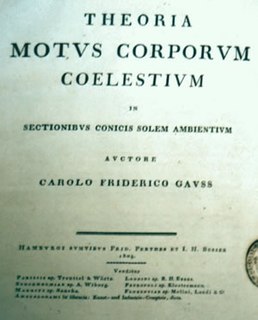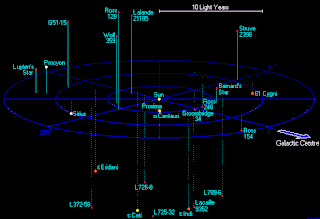Related Research Articles

The astronomical unit is a unit of length, roughly the distance from Earth to the Sun and equal to about 150 million kilometres or ~8 light minutes. The actual distance varies as Earth orbits the Sun, from a maximum (aphelion) to a minimum (perihelion) and back again once each year. The AU was originally conceived as the average of Earth's aphelion and perihelion; however, since 2012 it has been defined as exactly 149597870700 m.
Conversion of units is the conversion between different units of measurement for the same quantity, typically through multiplicative conversion factors.
The term ephemeris time can in principle refer to time in connection with any astronomical ephemeris. In practice it has been used more specifically to refer to:
- a former standard astronomical time scale adopted in 1952 by the IAU, and superseded in the 1970s. This time scale was proposed in 1948, to overcome the drawbacks of irregularly fluctuating mean solar time. The intent was to define a uniform time based on Newtonian theory. Ephemeris time was a first application of the concept of a dynamical time scale, in which the time and time scale are defined implicitly, inferred from the observed position of an astronomical object via the dynamical theory of its motion.
- a modern relativistic coordinate time scale, implemented by the JPL ephemeris time argument Teph, in a series of numerically integrated Development Ephemerides. Among them is the DE405 ephemeris in widespread current use. The time scale represented by Teph is closely related to, but distinct from, the TCB time scale currently adopted as a standard by the IAU.

The International Astronomical Union exists to promote and safeguard the science of astronomy through international cooperation, assign official names and designations to celestial bodies, and liaise with organizations that include amateur astronomers. Founded in 1919 and based in Paris, the IAU is a member of the International Science Council (ISC).
Terrestrial Time (TT) is a modern astronomical time standard defined by the International Astronomical Union, primarily for time-measurements of astronomical observations made from the surface of Earth. For example, the Astronomical Almanac uses TT for its tables of positions (ephemerides) of the Sun, Moon and planets as seen from Earth. In this role, TT continues Terrestrial Dynamical Time, which in turn succeeded ephemeris time (ET). TT shares the original purpose for which ET was designed, to be free of the irregularities in the rotation of Earth.
Universal Time (UT) is a time standard based on Earth's rotation. There are several versions of Universal Time, which differ by up to a few seconds. The most commonly used are Coordinated Universal Time (UTC) and UT1. All of these versions of UT, except for UTC, are based on Earth's rotation relative to distant celestial objects, but with a scaling factor and other adjustments to make them closer to solar time. UTC is based on International Atomic Time, with leap seconds added to keep it within 0.9 second of UT1.
In astronomy, axial tilt, also known as obliquity, is the angle between an object's rotational axis and its orbital axis, or, equivalently, the angle between its equatorial plane and orbital plane. It differs from orbital inclination.

The Gaussian gravitational constant is a parameter used in the orbital mechanics of the solar system. It relates the orbital period to the orbit's semi-major axis and the mass of the orbiting body in Solar masses.
Barycentric Dynamical Time is a relativistic coordinate time scale, intended for astronomical use as a time standard to take account of time dilation when calculating orbits and astronomical ephemerides of planets, asteroids, comets and interplanetary spacecraft in the Solar System. TDB is now defined as a linear scaling of Barycentric Coordinate Time (TCB). A feature that distinguishes TDB from TCB is that TDB, when observed from the Earth's surface, has a difference from Terrestrial Time (TT) that is about as small as can be practically arranged with consistent definition: the differences are mainly periodic, and overall will remain at less than 2 milliseconds for several millennia.
The astronomical system of units, formerly called the IAU (1976) System of Astronomical Constants, is a system of measurement developed for use in astronomy. It was adopted by the International Astronomical Union (IAU) in 1976 via Resolution No. 1, and has been significantly updated in 1994 and 2009.
Newcomb's Tables of the Sun is a work by the American astronomer and mathematician Simon Newcomb, published in volume VI of the serial publication Astronomical Papers Prepared for the Use of the American Ephemeris and Nautical Almanac. The work contains Newcomb's mathematical development of the position of the Earth in the Solar System, which is constructed from classical celestial mechanics as well as centuries of astronomical measurements. The bulk of the work, however, is a collection of tabulated precomputed values that provide the position of the sun at any point in time.
An astronomical constant is any of several physical constants used in astronomy. Formal sets of constants, along with recommended values, have been defined by the International Astronomical Union (IAU) several times: in 1964 and in 1976. In 2009 the IAU adopted a new current set, and recognizing that new observations and techniques continuously provide better values for these constants, they decided to not fix these values, but have the Working Group on Numerical Standards continuously maintain a set of Current Best Estimates. The set of constants is widely reproduced in publications such as the Astronomical Almanac of the United States Naval Observatory and HM Nautical Almanac Office.

In the theory of relativity, it is convenient to express results in terms of a spacetime coordinate system relative to an implied observer. In many coordinate systems, an event is specified by one time coordinate and three spatial coordinates. The time specified by the time coordinate is referred to as coordinate time to distinguish it from proper time.

Gart Westerhout was a Dutch-American astronomer. Well before completing his university studies at Leiden, he had already become well-established internationally as a radio astronomer in the Netherlands, specializing in studies of radio sources and the Milky Way Galaxy based on observations of radio continuum emissions and 21-cm spectral line radiation that originates in interstellar hydrogen. He emigrated to the United States, became a naturalized citizen, and held a number of important scientific and management positions in academic and government institutions.
In time standards, dynamical time is the time-like argument of a dynamical theory; and a dynamical time scale in this sense is the realization of a time-like argument based on a dynamical theory: that is, the time and time scale are defined implicitly, inferred from the observed position of an astronomical object via a theory of its motion. A first application of this concept of dynamical time was the definition of the ephemeris time scale (ET).
Elena Vladimirovna Pitjeva is a Russian astronomer working at the Institute of Applied Astronomy, Russian Academy of Sciences, St. Petersburg. She has published over 100 articles, as listed in Google Scholar and the Astrophysics Data System in the field of solar system dynamics and celestial mechanics . She began employment activity as an engineer-observer at the Astrophysical observation station of the Astronomical Observatory of Leningrad State University in Byurakan (Armenia). Then Pitjeva worked at the Institute of Theoretical Astronomy of the USSA Academy of Science and the Institute Applied Astronomy RAS since the date of its foundation in 1988 as researcher and senior researcher. At present she is head of the Laboratory of Ephemeris Astronomy of this institute. Major research interests of Dr. Pitjeva include the construction of numerical ephemerides of the planets, the determination of the planets' and asteroids' masses, the parameters of planet rotation and planetary topography, the solar corona and oblateness and general relativity testing. She is one of creators of the numerical Ephemerides of Planets and the Moon (EPM) of IAA RAS that originated in the seventies of the past century and have been developed since that time. The version of the EPM2004 ephemeris has been adopted as the ephemeris basis of Russian Astronomical Yearbook since 2006. The updated EPM2008 ephemerides are available to outside users via ftp. The works of Pitjeva have recently been used by several scientists to test several models of modified gravity in the Solar System. Dr. Pitjeva has also contributed to a better understanding an influence of asteroids and Trans-Neptunian Objects on the planets' motion. Recently Dr. Pitjeva collaborated with Dr. Standish and proposed to the IAU Working Group on Numerical Standards for Fundamental Astronomy (NSFA) the values of the masses of the three largest asteroids, the Moon-Earth mass ratio and the astronomical unit in meters, mainly obtained while fitting the constructed DE (JPL) and EPM planet ephemerides. These values have been adopted by the 27 General Assembly of International Astronomical Union as Current Best Estimates as the IAU (2009) System of Astronomical Constants. Pitjeva is a member of the International Astronomical Union: OC of Commission 4 “Ephemerides”, Commission 52 “Relativity in Fundamental Astronomy” IAU WG NSFA.”,

The light-year is a unit of length used to express astronomical distances and is equivalent to about 9.46 trillion kilometres (9.46×1012 km) or 5.88 trillion miles (5.88×1012 mi). As defined by the International Astronomical Union (IAU), a light-year is the distance that light travels in vacuum in one Julian year (365.25 days). Because it includes the word "year", the term light-year may be misinterpreted as a unit of time.
Planetary mass is a measure of the mass of a planet-like object. Within the Solar System, planets are usually measured in the astronomical system of units, where the unit of mass is the solar mass (M☉), the mass of the Sun. In the study of extrasolar planets, the unit of measure is typically the mass of Jupiter (MJ) for large gas giant planets, and the mass of Earth (M⊕) for smaller rocky terrestrial planets.

Coordinated Universal Time or UTC is the primary time standard by which the world regulates clocks and time. It is within about 1 second of mean solar time at 0° longitude, and is not adjusted for daylight saving time. It is effectively a successor to Greenwich Mean Time (GMT).
Ye Shuhua is a Chinese astronomer and professor at Shanghai Astronomical Observatory, known for achieving one of the world's most precise measurements of Universal Time in the 1960s, and for establishing the very-long-baseline interferometry (VLBI) and satellite laser ranging (SLR) techniques in China.
References
- ↑ Müller, Edith A.; Jappel, A., eds. (1977), "IAU (1976): Proceedings of the 16th General Assembly, XVI B" (PDF), Transactions of the IAU, Dordrecht: D.Reidel, p. 31, ISBN 90-277-0836-3 Missing or empty
|title=(help) - 1 2 3 4 5 6 IAU(1976) ibidem: Commission 4 (Ephemerides) recommendations 1,2,3,5,6: pp.52..67
- ↑ Appenzeller, I, ed. (1994), "IAU (1994): Proceedings of the 22nd General Assembly, XXII B" (PDF), Transactions of the International Astronomical Union: Proceeding of the Twenty-Second General Assembly, the Hague 1994, Transactions of the IAU, Kluwer Academic, ISBN 0-7923-3842-1
- ↑ IAU(1994) ibidem, Resolution No. C 6
- ↑ Standish, E.M. (1995), "Report of the IAU WGAS Sub-group on Numerical Standards", in Appenzeller, I. (ed.), Highlights of Astronomy (PDF), Dordrecht: Kluwer, archived from the original (PDF) on 2012-09-07
- 1 2 3 4 5 6 7 8 9 10 11 12 13 14 15 16 17 18 19 20 21 Seidelmann, P. Kenneth (1977). "Numerical values of the constants of the Joint Report of the Working Groups of IAU Commission 4". Celestial Mechanics. 16 (2): 165–177. Bibcode:1977CeMec..16..165S. doi:10.1007/BF01228598. S2CID 123361221.
- ↑ Wayman, P., ed. (1980), "IAU (1979): Proceedings of the 17th General Assembly, XVII B" (PDF), Transactions of the International Astronomical Union, Volume XVIIB, Transactions of the IAU, Dordrecht: D.Reidel, ISBN 90-277-1159-3
- ↑ West, R, ed. (1982), "IAU (1982): Proceedings of the 18th General Assembly, XVIII B" (PDF), Transactions of the International Astronomical Union: Proceeding of the Twenty-Second General Assembly, the Hague 1994, Transactions of the IAU, Dordrecht: D.Reidel, ISBN 0-7923-3842-1
- ↑ IAU(1979) ibidem, recommendation by Commissions 4 (Ephemerides), 8 (Positional Astronomy), 19 (Rotation of the Earth), 31 (Time)
- 1 2 Lederle, Trudpert (1980). "The IAU (1976) System of Astronomical Constants". Mitteilungen des Astronomisches Gesellschaft. 48: 59..65. Bibcode:1980MitAG..48...59L.
- ↑ IAU(1982) ibidem, Resolution No. C 5
- 1 2 IAU(1979) ibidem, recommendation by Commissions 4 (Ephemerides), 19 (Rotation of the Earth), 31 (Time)
- ↑ IAU(1982) ibidem, Resolution No. R 3
- ↑ IAU(1976) ibidem, recommendation by Commissions 4 (Ephemerides) and 16 (Physical Study of Planets and Satellites)
- ↑ IAU(1979) ibidem, recommendation by Commissions 4 (Ephemerides) and 16 (Physical Study of Planets and Satellites)
- ↑ International Bureau of Weights and Measures (2006), The International System of Units (SI) (PDF) (8th ed.), pp. 112–13, ISBN 92-822-2213-6, archived (PDF) from the original on 2017-08-14.
- ↑ CODATA System of Physical Constants of 1973, CODATA Bulletin No. 11 Archived 2017-01-07 at the Wayback Machine
- ↑ originally (Seidelmann 1977) listed as 9.2109", derived from Woolard
- ↑ IAU(1982) ibidem, Resolution No. C 10